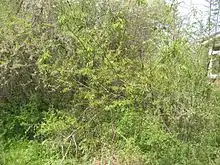Salix udensis
Salix udensis (syn. S. sachalinensis F.Schmidt) is a species of willow native to northeastern Asia, in eastern Siberia (including Kamchatka), northeastern China, and northern Japan.[1]
| Salix udensis | |
|---|---|
 | |
| Salix udensis 'Sekka' | |
| Scientific classification | |
| Kingdom: | Plantae |
| Clade: | Tracheophytes |
| Clade: | Angiosperms |
| Clade: | Eudicots |
| Clade: | Rosids |
| Order: | Malpighiales |
| Family: | Salicaceae |
| Genus: | Salix |
| Species: | S. udensis |
| Binomial name | |
| Salix udensis | |
It is a deciduous shrub growing to 5 m (16 ft) tall. The leaves are slender, lanceolate, 6–10 cm long and 0.8–2 cm broad, glossy dark green above, glaucous and slightly hairy below, with a serrated margin. The flowers are produced in early spring on catkins 2–3 cm long.[2] It typically takes 20 years to reach maturity.[3]
The cultivar S. udensis 'Sekka' (Japanese fantail willow) is grown as an ornamental plant; it has fasciated stems (stems that are joined abnormally in a flattened arrangement—hence "fantail"), highly prized by Ikebana flower arrangers.[2] The Sekka cultivar has also been found to be resistant to plant pathogens such as rust (Melampsora spp.) caused by pathogenic fungi.[4]
References
- "Salix udensis". Germplasm Resources Information Network. Agricultural Research Service, United States Department of Agriculture. Retrieved 21 January 2018.
- Huxley, A., ed. (1992). New RHS Dictionary of Gardening. Macmillan ISBN 0-333-47494-5.
- "Salix udensis". Boone County Arboretum.
- Pei MH, Ruiz C, Shield I, Macalpine W, Lindegaard K, Bayon C, Karp A (2010). "Mendelian inheritance of rust resistance to Melampsora larici‐epitea in crosses between Salix sachalinensis and S. viminalis". Plant Pathology. 59 (5): 862–872. doi:10.1111/j.1365-3059.2010.02317.x.
External links
- Global Biodiversity Information Facility (BGIF)
- Royal Horticultural Society
- Missouri Botanical Garden
- Chicago Botanical Garden
- North Carolina Extension Gardener
- Boone County Arboretum
- Google search for images